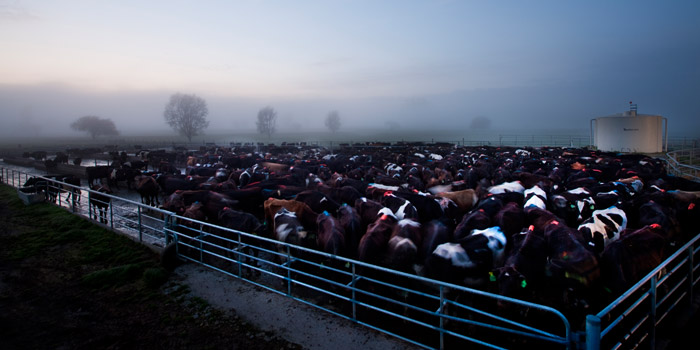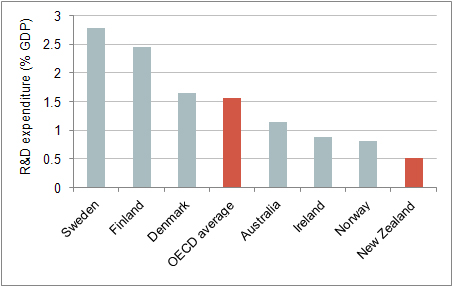Agritechnology development, adaptation and use is second nature to New Zealanders throughout the primary production sector. Farmers and growers are focussed on doing things better – looking after their soil, plants and animals. They’re looking after the water and air, as well, ensuring that effluent and chemicals stay where they can do most good. Economic sense aligns with environmental stewardship, and New Zealand ranks highly in the world in both agricultural productivity and environmental performance.
An International Farm Comparison Network (IFCN) Dairy Research Centre study of 46 countries published last year showed that New Zealand has amongst the lower costs of production. Uruguay and Chile, with far lower minimum wage structures than in New Zealand, produce milk slightly more cheaply.
In environmental quality, New Zealand rates highly in the OECD comparators. The Ministry for Environment currently has the following on its website:
International comparisons of river water quality are difficult for a number of reasons – differences in site selection, differences in methodology, and differences in approaches to dealing with high concentrations. However, based on the most recent OECD data from 2002 until 2004, the median concentrations for nitrate-nitrogen and total phosphorus in the three New Zealand rivers included in the study (Clutha, Waitaki and Waikato Rivers) compare well to other OECD countries (top third for total phosphorus and top 5% for nitrate-nitrogen).
While it is acknowledged that a study of three rivers does not represent the whole of New Zealand, the Waikato does flow through dairy country, and it is consented discharges from City Councils that are causing the problems in the Manawatu and Whanganui rivers. Unlike some city councils, farmers have invested in modern effluent disposal systems. Federated Farmers of New Zealand has calculated that dairy farmers have spent over a billion dollars in the last five years on environmental compliance. Approximately 70% of the expenditure has been on effluent systems which have enabled retention of nutrients on farm, and improved productivity – that is output per unit of inputs.
StatisticsNZ data support the case for productivity gains in agriculture. Since 1978, agricultural labour productivity has been 3.5% per year growth (in comparison with 1.5 and 1.4 for manufacturing and service sector); capital productivity has been 2.3% growth a year (manufacturing -1.9% and service -0.5%) and multifactor productivity growth for agriculture has been 2.9% per year (manufacturing 0.2% and service 0.6%).
In the dairy sector, for instance, production of milk solids per hectare has increased by 2.0% a year, the bulk of the contribution being from an annual increase in milk solids of 1.7% per cow due to improved cow genetics and better feeding. Increased use of maize silage and the feeding of high energy Palm Kernel Expeller – a by-product of the palm oil industry – has increased resilience in the dairy industry. Since the drought of 2008/09, profit from productivity (that is, the difference between the operating profit and the profit that would have been achieved without gains in productivity) has been an extra $700 to $1100 a year. DairyNZ describes the profit from productivity as a measure of cost-efficient milk solid production.
StatisticsNZ data released at the end of June indicate that New Zealand’s labour productivity from 2000 to 2008 and 2008-2013 increased 1.4% and 1.0% respectively, while capital productivity decreased 0.4 and 1.2% overall in the two time periods. Multifactor productivity increased slightly in the 2000-2008 period but didn’t change from 2008 to 2013.
In considerable contrast, the agricultural sector’s performance since 2008 has been stellar – 5.4, 3.9 and 4.6% for labour, capital and multifactor productivity respectively.
These gains have been achieved on the back of considerable farmer investment in technologies and have resulted in an export industry worth an ever-increasing amount to New Zealand. A Coriolis report to New Zealand Trade and Enterprise last year identified that agritech exports were worth NZ $1.2 billion in 2013 and had grown 4% per year over the past five years. Animal health products were worth NZ $311m in 2013, with fencing supplies and equipment and machinery and systems, both worth over $300m. Biggest growth (32% a year) has been in animal genetics on the back of dairy cows to China, and as less developed countries move into modern agriculture, agritechnology suppliers have benefitted. However, some developing countries are now moving into self-sufficiency; in 2013 the dairy cow exports were worth approximately $48 million but this year the demand has crashed.
What is needed is an exploration of new markets, not only the obvious ones such as South America and Asia, but also in countries where subsidies have not created the need for the new technologies… and now that subsidies are being withdrawn (albeit gradually) the need for agritechnology is increasing.
The biggest challenge for the future could, however, be the development of new ideas for New Zealand and then the rest of the world.
Much has been written on the New Zealand science system and whether it is or isn’t creating what is necessary. Comparison with OECD countries indicates that New Zealand invests considerably less in research and development (R&D) than most developed countries. The World Bank lists New Zealand investment as 1.27% of GDP in 2011; Ireland was 1.66%, UK was 1.78%, Netherlands 2.03%, Denmark 2.98% and Finland 3.80%.
StatisticsNZ has examined expenditure in other ‘small advanced economies’ and concluded that “Our business sector’s R&D spending is relatively low. Finland and Denmark have business sector R&D spending above 2 percent of gross domestic product (GDP), and Israel’s is above 3 percent. Singapore’s business R&D is above 1 percent. New Zealand’s is sitting at around 0.5 percent of GDP.
More data from StatisticsNZ on product innovation in companies employing more than 5 employees, indicates only 17% of New Zealand companies are active in comparison with 23% of companies in Denmark, 31% in Finland and 28% in Ireland.
Recent Government focus has been on trying to encourage more business involvement, but government spending on R&D is still somewhat below that required to kickstart investment.
Research by Professor Sir Peter Gluckman, the Chief Science Adviser to the Prime Minister, indicates that at a public sector spend of 0.8% GDP on R&D, private sector spending takes off. He argues that because of New Zealand’s history and geographical position, plus dearth of multi-national companies, ‘we might have to go even higher’.
Targeting areas with potential for growth has often been tried, but not necessarily with success. However, Coriolis has identified five indicators for success in the agritechnology sector: difficult to replicate; use of sophisticated technology; protection by patents or IP; a well-established and integrated skill set; consumer willingness to pay a premium for quality.
Aligning research strategy with our comparative advantage in agriculture and needs for the future, with the assistance of the five indicators, could be the route to the next jump in exports. A McKinsey report entitled ‘Pursuing the global opportunity in food and agribusiness’ released in July makes the opportunities clear. Successful investment strategies will find ‘opportunities to capture value (for example, technology or processing that improves feed performance or reduces feed-production cost)’ or mitigate the risks. Although the latter referred to vertical integration within the protein value chain, it also applies to the need to reduce risk in production which assists with productivity.
New Zealand’s track record in agritechnology is strong and bodes well for the future. Encouragement in small business, as well as in the government-funded bodies, is required to ensure that research direction and agri-sector needs are aligned. Once that has been done it will be the modern day equivalent of ‘light the blue touch paper and stand well back’ – because agritechnology is what New Zealanders have always done and done well. The facts, evidence and data stand for themselves.






Leave a comment